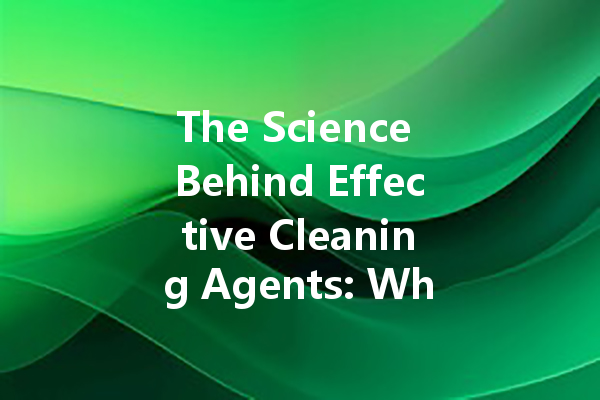Cleaning agents play a vital role in maintaining hygiene and cleanliness in our homes, offices, and various other environments. Understanding the science behind these cleaning solutions can help you make informed choices about the products you use daily. This article will explore the key components of effective cleaning agents, the mechanisms that make them work, and considerations for choosing the right products for your needs.
What Are Cleaning Agents?
Cleaning agents, also known as cleaning products or detergents, are substances designed to remove dirt, stains, and impurities from surfaces. They can come in various forms, such as liquids, powders, sprays, or wipes. Common cleaning agents include multi-surface cleaners, detergents, disinfectants, and soaps, each formulated to target specific cleaning challenges.
Key Components of Cleaning Agents
Surfactants
One of the primary components of most cleaning agents is surfactants. Surfactants are molecules that contain both a hydrophilic (water-attracting) and a hydrophobic (water-repelling) end. When added to water, surfactants disrupt the surface tension, allowing water to spread and penetrate surfaces more effectively. This property is crucial for lifting dirt and oil from various surfaces.
Solvents
Solvents are another essential ingredient found in many cleaning products. They dissolve substances that are not easily removed by water alone, such as grease and oils. Common solvents include alcohols, glycerin, and glycol ethers. The choice of solvent is crucial, as it affects the overall effectiveness of the cleaning agent.
Acids and Bases
Some cleaning agents contain acids or bases, which can effectively break down specific materials. For example, acidic cleaners can dissolve mineral deposits, while alkaline cleaners are excellent for cutting through grease and organic materials. Understanding the pH level of a cleaning agent can help you determine its suitability for various applications.
How Cleaning Agents Work
Mechanism of Action
Cleaning agents work through different mechanisms, depending on their formulation and intended use. Surfactants, for example, reduce surface tension, allowing water to penetrate and lift dirt. Once the dirt is suspended in the cleaning solution, it can be easily wiped away or rinsed off.

Acids and bases chemically alter substances, breaking them down into more manageable components. For instance, acidic cleaners can dissolve limescale or rust, while alkaline cleaners can saponify fats, turning them into soap, which can be easily washed away.
Emulsification
Emulsification is another critical process in cleaning. When oils and water do not mix, surfactants help create an emulsion — a stable mixture of both. This allows oil and grease to be effectively removed from surfaces when cleaned with water-based solutions.
Choosing the Right Cleaning Agent
Understanding Your Needs
When selecting a cleaning agent, it’s essential to identify your specific cleaning needs. Consider factors such as the type of surface you’ll clean (like wood, tile, or fabric), the nature of the stains or dirt (grease, dust, or grime), and any safety concerns, such as the presence of children or pets.
Evaluating Ingredients
Take the time to read labels and understand the ingredients in cleaning agents. Opt for products that use safe, non-toxic components, especially if they will be used in homes with pets or young children. Look for eco-friendly options, as they often have a lower environmental impact without compromising on effectiveness.
Effectiveness and Safety
The effectiveness of a cleaning agent should also be balanced with safety. Some cleaning products contain harsh chemicals that can be effective but may cause skin irritation or negatively impact indoor air quality. Look for cleaning agents that provide both efficacy and safety to enhance your cleaning routine.
Final Thoughts
Understanding the science behind effective cleaning agents can empower you to make better decisions when it comes to maintaining cleanliness and hygiene in your environment. By knowing the key components, mechanisms of action, and what to look for in cleaning products, you can choose solutions that meet your needs while prioritizing safety and effectiveness. Whether you’re tackling tough stains or simply ensuring your spaces are clean and healthy, the right cleaning agent can make all the difference.
